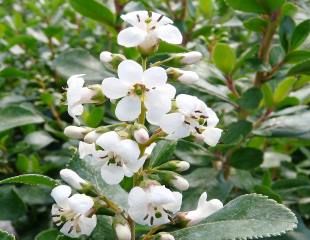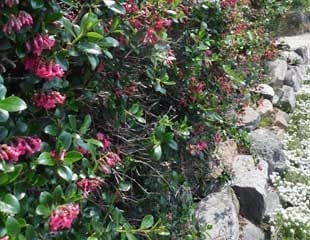


How to Grow Escallonia
Escallonia is a summer flowering, evergreen shrub which originates from South America. It has attractive glossy leaves and a profusion of flowers in early summer, which are usually pink, red or white, and in some varieties, scented.
Escallonia looks good as a specimen shrub, but also makes a great hedge. Escallonia is ideal for seaside gardens being tolerant of salt spray. I took the image on the above right of an Escallonia hedge growing in Guernsey. Not all Escallonias are fully hardy and are best planted away from cold winds. In the image below, the Escallonia is growing in a part of the UK that experiences cold temperatures. However, it is planted in a raised bed, which keeps the shrub dry and allows it to tolerate colder temperatures. Winter wet is the enemy here.
More info below.
Where to plant Escallonia
The point to note when growing Escallonia is that it is slightly tender, which means it is not suitable for cold or exposed gardens. Escallonia is described as H4 hardy,(what does frost hardy mean?) which is hardy in most of the UK as -5-10 degrees. In reality, although hardy, all varieties are best grown in a sheltered spot. In a bad winter Escallonia can suffer with die back on the leaves and scorching. The one thing Escallonia will not tolerate is winter wet. If the soil is heavy, or clay, it will need to be improved with organic matter.
Escallonia is best planted in full sun into good, well-drained soil away from cold winds. Escallonia will flower and tolerate dappled/light shade as long as light levels are good. Escallonia is trouble free, requiring no maintenance. As with all newly planted shrubs, water, water and water again until the roots are down and can absorb water for themselves.
How to prune Escallonia

Escallonia is a low maintenance shrub which does not require annual pruning. You can prune Escallonia, but as you can see from the image left, Escallonia has a nice natural shape with an arching habit and make look at its best with only a very light prune.
For pruning timing is important. Do not prune in the spring as you will cut off the branches with embryo flowers, resulting in little or no flowers that year.
It can be tempting to take the secateurs to the garden in the spring. Escallonias and all spring flowering shrubs should only be pruned after flowering, later in the summer. Either do not prune it or prune it with just a light shearing after flowering in late summer.
Escallonia grows to around 3m with 2.5m spread. This means if you are growing Escallonia as a hedge (and it is a popular hedging plant,) shrubs need to be planted about 45 cms apart. If the Escallonia has outgrown its allotted space, it is possible to prune it harder to re shape and reduce in size. If an Escallonia has got out of hand, it will respond to hard pruning, although it may not flower the year after pruning it will recover.
Which variety of Escallonia are best?
All Escallonia flowers are attractive to bees.
The choice of Escallonia for your garden is personal preference, but also may depend on the aspect of your garden. The more exposed your garden/selected planting place, the greater the need for hardiness of the Escallonia variety.
- Escallonia 'Apple Blossom' illustrated top left, is a compact variety, with a profusion of scented flowers from early to midsummer which are white, flushed apple-blossomed pink H4 hardy which means it needs to be planted in a sheltered spot, 2.5 x 2 (height.) Apple Blossom has some of the largest flowers in this group and is a really pretty shrub- available on Crocus (affiliate link).
- Escallonia 'Donard Seedling' a vigorous shrub which flowers white, flushed pink, early to mid summer from pink buds and has very attractive glossy foliage. 'Donard Seedling' is one of the hardiest of Escallonia to grow, making it more suitable for colder inland gardens, but plant away from cold winds. Growing to 3 x 2.5 m - this variety is available from Thompson and Morgan (affiliate link)
- Escallonai 'Iveyi' illustrated above centre is an RHS award winning variety with larger, dark green foliage and pure white flowers, but it is only H4 hardy and so only suitable for sheltered and coastal gardens. Overall size 3 x 3m. It is one of the most popular Escallonia to grow and its flowers are described as scented- also available from Crocus
- Other varieties of Escallonia are E.Leucantha which is large 3.5 x 3m with white flowers but needs the shelter of south-facing wall is H4 hardy.
- E. Virgata is similar, but smaller and H4 hardy
- E. 'Langleyensis' which is evergreen or semi-evergreen and more arching in appearance with pink/red flowers and again ** hardy.
- There are only two other varieties of Escallonia which are H5 which is hardy to -10-15 degrees namely, E. 'C.F.Ball' which is bright red flowering and 'Edinensis' pink/red flowering.
- There are now some dwarf varieties of Escallonia such as E.'Pink Pixie' which, as the name suggests, has lovely pink flowers, (not scented) the same glossy leaves but only grows to around 80cms x 80cms and is fast growing. Ideal for container growing on a patio or balcony.
- Similar is E. Pink Elle, a little larger reaching 100cms, and E. rubra ‘Pygmaea’ about 75cms.
- There is a variety with golden leaves, E. laevis ‘Gold Ellen’, although to my mind it doesn't look anywhere near as handsome as those varieties with the dark green glossy leaves.
If you have a garden on the coast, or in a sheltered spot, there are many varieties of Escallonia which will suit your garden but if your plot is exposed or cold, the main choice is 'Donard Seedling' which is lovely.
More varieties of Escallonia to view and on sale at Crocus and Thompson and Morgan
For an alternative similar shrub, as in an evergreen flowering shrub with scented flowers, but which is more hardy, try Choisya.
Check out Fast Growing Evergreen Shrubs and shrubs for shade for more planting ideas.

Although Escallonia are a bit fussy about their growing conditions, being slightly tender, they are easy to grow and maintenance free.
